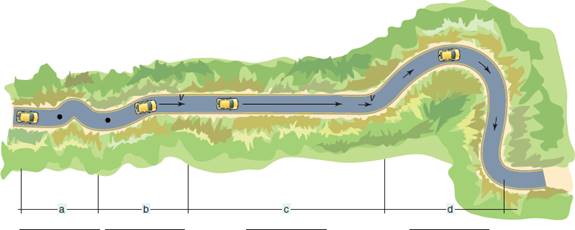
Concept explainers
Visualize the connections and give the descriptive motion answers in the blanks.

Answer to Problem 1VC
(a)Speed
(b)Uniform velocity
(c)Accleration(change in velocity magnitude)
(d)Accleration(change in velocity magnitude and direction)
Explanation of Solution
Speed is a scalar quantity. It has only magnitude and no direction. It is the total distance traveled per unit time.
Velocity is a vector quantity. It has both magnitude and direction. It is the displacement per unit time. Uniform velocity implies equal velocity for equal intervals of time.
Acceleration is a vector quantity. It is the rate of change of velocity. A body moving in a curve has centripetal force exerting on it. For a force, there must be some acceleration. The change in the direction of the velocity also causes the body to accelerate.
Conclusion:
Therefore, this visual image can be connected as follows,
(a)Speed
(b)Uniform velocity
(c)Accleration(change in velocity magnitude)
(d)Acceleration(change in velocity magnitude and direction)
Want to see more full solutions like this?
Chapter 2 Solutions
An Introduction to Physical Science
- 3aarrow_forward44 please help with the this.arrow_forward4a Which of the following values COULD NOT be a magnitude? Choose all that apply. 626 0 -0.806 8.63 -48.5 72 131 156 4b Px = -1248 & Py = 261. Determine P.P = Qx = -1540 & Qy = 375. Determine Q.Q = 4c. T = 1105 & Ty = 425. Determine the two possible values for Tx. 4d. Uy = -38. Which of the following COULD NOT be the value of U? Choose all that apply. 10 70 72 31 47 0 75 38 4e. R has a magnitude of 165. Which of the following COULD be Rx? Choose all that apply. 165 -171 155 0 -156 -165 172 -130arrow_forward
 An Introduction to Physical SciencePhysicsISBN:9781305079137Author:James Shipman, Jerry D. Wilson, Charles A. Higgins, Omar TorresPublisher:Cengage Learning
An Introduction to Physical SciencePhysicsISBN:9781305079137Author:James Shipman, Jerry D. Wilson, Charles A. Higgins, Omar TorresPublisher:Cengage Learning Glencoe Physics: Principles and Problems, Student...PhysicsISBN:9780078807213Author:Paul W. ZitzewitzPublisher:Glencoe/McGraw-Hill
Glencoe Physics: Principles and Problems, Student...PhysicsISBN:9780078807213Author:Paul W. ZitzewitzPublisher:Glencoe/McGraw-Hill College PhysicsPhysicsISBN:9781938168000Author:Paul Peter Urone, Roger HinrichsPublisher:OpenStax College
College PhysicsPhysicsISBN:9781938168000Author:Paul Peter Urone, Roger HinrichsPublisher:OpenStax College University Physics Volume 1PhysicsISBN:9781938168277Author:William Moebs, Samuel J. Ling, Jeff SannyPublisher:OpenStax - Rice University
University Physics Volume 1PhysicsISBN:9781938168277Author:William Moebs, Samuel J. Ling, Jeff SannyPublisher:OpenStax - Rice University Principles of Physics: A Calculus-Based TextPhysicsISBN:9781133104261Author:Raymond A. Serway, John W. JewettPublisher:Cengage Learning
Principles of Physics: A Calculus-Based TextPhysicsISBN:9781133104261Author:Raymond A. Serway, John W. JewettPublisher:Cengage Learning





